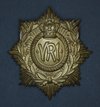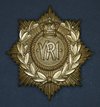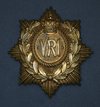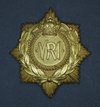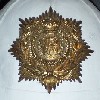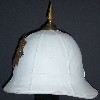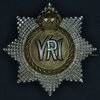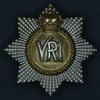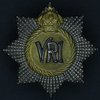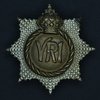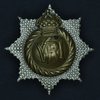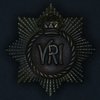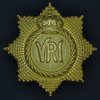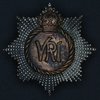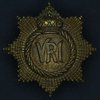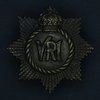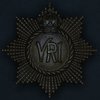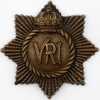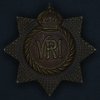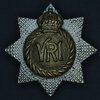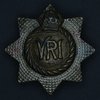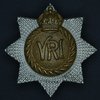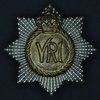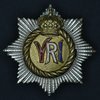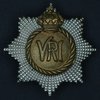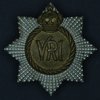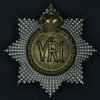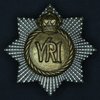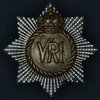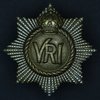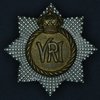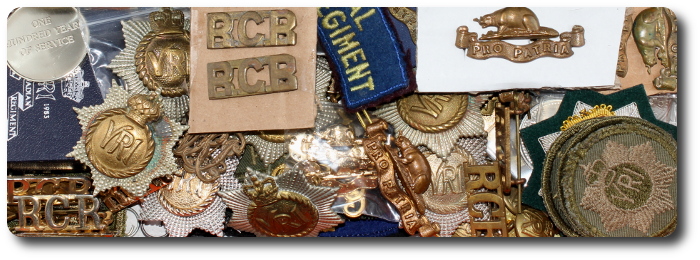
Badges of The Royal Canadian Regiment
1894 - 1902 & 1919 - 1927
1894 Pattern Helmet Plates and Cap Badges
1894 Pattern Helmet Plates
The 1894 Pattern Helmet Plate and the "Universal" Helmet
1894 Pattern Cap Badges
Notes and References
1894
Militia General Order 35 May 1894
2.c. Royal Regiment of Canadian Infantry
Helmet Plate: In gilt metal, a star. On the star a laurel wreath. Within the wreath, the Royal and Imperial cypher (V.R.I.) in relief on pebbled ground and raised border surmounted by the Imperial Crown. Dimensions of plate from top to bottom of the star, back measurement, 4 1/4 inches; extreme horizontal width, 3 3/4 inches.
Buttons: gilt, plain with the Royal and Imperial cypher (V.R.I.) surmounted by the Imperial Crown.
Forage Cap Badge: A silver eight-pointed star, with a raised gilt circle same as for centre of the helmet plate, but in proportion, the Royal and Imperial cypher (V.R.I.) in frosted gilt, surmounted by the Imperial Crown, dimensions of the star, 2 inches.
Collar Ornaments for Officers: In frosted silver, the Canadian Beaver on a scroll inscribed the motto Pro Patria in relief; dimensions, length 2 inches, breadth 7 / 8 of an inch.
Pouch Ornament for Officers: Gilt, the Royal and Imperial cypher (V.R.I.) surmounted by the Imperial Crown; dimensions from top of crest to bottom of ornament, 2 1/4 inches; extreme horizontal width, 2 inches.
Waist Plate: Round gilt clasp, universal ends. The Royal and Imperial cypher (V.R.I.) surmounted by the Imperial crown, in silver relief on pebbled gilt centre, with outer circle the designation "Royal Canadian Regiment" in relief.
Waist Belt and Pouch Belt: Brown leather.
Shoulder Strap Ornament for Rank and File: The Royal and Imperial cypher (V.R.I.) surmounted by the Imperial crown, for sergeants, water gilt, rank and file, gilding metal; dimensions from top of crest to bottom of ornament, 1 3/4 inches; horizontal width, 1 1/4 inches.
Staff sergeants, the Royal and Imperial cypher surmounted by the Imperial crown, to be embroidered on strap in gold of specified dimensions, on blue cloth shoulder strap.
For N.C. Officers and Men
Helmet Plates and Buttons. Same as described for officers; sergeants, water gilt; other ranks, gilding metal.
(as presented in The RCR Museum Archives document 14-3076-1894/930)
1917
Herald's
College,
London, E.C.
21 November 1917
Dear Sir,
In reply to your letter of the 17th inst. the Crown on your paper is certainly not the Imperial Crown of England.
I understand that in April 1918 your new Colonel was about to ask for official sanction to retain Queen Victoria's Royal and Imperial Cypher.
If any special badge was to be designed for the Royal Regiments in Canada it would rewuire the appraal of the King.
Perhaps you could call here when you are next in town so that we could talk this matter over.
Yours faithfully
(signed) H Farnham
Burke
Norroy
King of Arms
Harry T. Cock, Esq.
The Bungalow,
Bramshott,
Liphook
1918
The Royal Canadian Regiment
B.E.F. France
The Military Secetary to
H.R.H. The Duke of Connaught
York House London S.W.
Sir,
H.R.H. The Duke of Connaught is Honorary Colonel of the Regiment.
I should be greatly obliged if you would let me know whether it would be possible for him to lay the following matter before H.M. the KING.
In 1893, Queen Victoria granted The Royal Canadian Regiment permission to wear "Her Imerial Cypher surmounted by the Imperial Crown" as a badge. About 1902, The Department for Militia and Defence for Canada, asked permission for Units of the Permanent Force of the Dominion to be allowed to substitute "the Royal Cypher ensigned with the Imperial Crown" (namely E.R. VII) for V.R.I. The Regiment immediately requested permission from the Militia Department to be allowed to retain the original badge (V.R.I.) so as to possess a permanent record of the reign in whch the Regiment was raised, and of Queen Victoria.
Much correspondence followed to the effect that the alteration had already been approved, that it could not be again altered, that it would not be tactful to ask the reigning Sovereign to substitute a cypher other than his own, etc.
The Regiment has always been most anxious to retain the distinctive V.R.I. and keep it as a permanent badge.
The Regiment has for a number of years at its own expense suppled V.R.I. badges for the men.
It is beieved that his Royal Highness was approached on the matter and that he expressed himself favourable to it but owing to the outbreak of war, the whole question was dropped, and no official application was made.
There is one difficulty to be met.
Sealed patterns of the badges etc., were approved by the Militia Department after the original grant of the Imperial Cypher and Crown. These sealed patterns differed from the usual "Queen's" crown and cypher. As the Regiment has however worn them all these years it is anxious to be allowed to retain them.
Enquiries were made at the War Office, a little while ago on the subject. The War Office stated they had nothing to do with the granting or design of Canadian badges.
A copy of the Short History of the Regiment (issued to all ranks) is enclosed. The cover shows roughly the design of the badge at present worn.
The Regiment would consider the highest honour to be allowed to officially resume the badge granted to it in 1893 by Her late Majesty Queen Victoria, in the form it was interpreted by the Canadian authorities which has been worn for over twenty six years.
I have the honour to be,
Sir,
Your obedient servant.
H.T.C.
Captain
Commanding, The Royal Canadian Regiment
10-12-1918
. . . . at the time when Lieut.-Col. Seely Smith assumed command of The Royal Canadian Regiment [1924], the design of the Regiment's badges was under discussion, as it had been for many years. When Her Majesty Queen Victoria, in 1893, granted the Regiment the right to wear her cypher, ensigned with the Imperial crown, a design was drawn by officers of the unit and approved by Militia Headquarters. Heraldically, this design was incorrect in several respects, notably in that the crown surmounting the cypher was not the Imperial crown, but a Hanoverian type, which, for a Canadian unit, was entirely inappropriate. This and other errors were not realized at the time and the badges were issued for the Regiment's use. - (pp. 212, The Royal Canadian Regiment; 1883-1983, R.C. Fetherstonaugh,1936)
There is evidence that, although the Edward VII and George V cyphered badges were those formally authorized, officer of the Regiment continued to wear the 1894 "VRI" pattern badge between 1902 and 1919. Officers' studio photos taken in 1910 and 1912, including a presentation photo set given to Lt Col. Wadmore on relinquishing command.
This is supported by contributions to threads on the subject on the forums at The RCR Association Message Board and the Canadian Expeditionary Force Study Group. My thanks to contributors at both sites for their helping in clarifying this issue.
Hugh Conway at The RCR Association Message Board writes:
"I am a long time collector of Regimental militaria. I have over 30 different badges in my collection. During the First War The Regimental Officers wore, on parade dress, a 3 piece VRI cypher badge and with field dress a one piece copper badge again with the VRI cypher. The other ranks wore a 2 piece badge with GVR cypher. The Regiment was granted the right to wear Queen Victoria's cypher on our hat badge in 1893. The Regiment applied to Buckingham Palace to have the right "in perpetuity" in 1900 but didn't go through Militia Headquarters. The Queen granted the request but, Militia Headquarters "had their backs up". The Regimental Officers continued to wear the Victoria cypher after her passing but the OR's badges bore the cypher of the reigning monarch until 1919 when official approval for the wearing of Queen Victoria's cypher was finally granted. Pro Patria, Hugh Conway"
The lengthy comments from a number of posters at the Canadian Expeditionary Force Study Group are best read in that location.
1919
General Orders 1919
G.O. 53/1919
Regimental Crest--Royal Canadian Regiment
His Majesty the King has been graciously pleased to approve of the Royal Canadian Regiment retaining in perpetual use the cypher "V.R.I." on the badges and buttons of the regiment.
H.Q. 1-1-8
P.C. 1299 of 23-6-19
In 1977, a letter to the Regiment from the Director of Ceremonial confirmed that correspondence preceding General Order No. 53 or 1919 included a letter from the British Secretary of State for War, Lord Milner. Documents on the matter are described as containing two footnotes governing the use of the rendition of Queen Victoria's Cypher:
a. The Crown must be depicted as it was whenever Her late Majesty's Cypher is used, as the two are inseparable. (See Victorian version of the Royal Arms attached).
b. The letters VRI may be depicted in a variety of ways; that approved for use by the RCR is as three separate letters neither entwined nor superimposed.
(RCR Museum document package 14-4767-1983)
1919
Soon after the Armistice in 1918, Major H. T. Cock, M.C., who was temporarily in command of the Expeditionary Force battalion, reopened the question [of wearing Queen Victoria's cypher on the Regiment's badges] and, with the permission of the Commanding Officer, wrote to Field-Marshal His Royal Highness the Duke of Connaught, Honorary Colonel of the Regiment, explaining the questions that had arisen and the Regiment's point of view. As a result of His Royal Highness's sympathetic reception of this letter and of representations made subsequently to him by Lieut.-Col. Hill, who lunched with him at his command, His Majesty King George V, in 1919, granted The Royal Canadian Regiment the right to wear in perpetuity the cypher V.R.I. - (pp. 212, The Royal Canadian Regiment; 1883-1983, R.C. Fetherstonaugh,1936)
1919
Downing Street
20 March 1919
CANADA
No. 108
My Lord Duke:--
I have the honour to acknowledge the receipt of Your Excellency's despatch No. 53 of the 31st of January, forwarding, for submission on to His Majesty the King, a request that the Royal Canadian Regiment may be allowed to retain in perpetual use the cypher "V.R.I.".
2. In this connecting I would refer you to Lord Minto's despatch No. 138 of the 7th April, 1903, and to the connecting correspondence from which it will be seen that it was then decided that the cypher to be used by the Royal Canadian Regiment should be that of the reigning Sovereign. This, I am informed, is the invariable rule with all the Colonies.
3. I observe, however, that while your despatch refers to the general use of the cypher "V.R.I." without reservation, the letter from His Royal Highness the Duke of Connaught, which was enclosed therein, restricts the use to regimental buttons and badges.
4. I should be glad to learn, therefore, whether the present proposal is that of the use of the Cypher, "V.R.I." should be confined to the regimental badges and buttons.
I am advised by the Army Council that they see no material objection to this restricted use of the Cypher in question, though the badge of the Regiment as borne on the Colours and as shown in the Army List, would remain as at present, viz. "The Royal Cypher ensigned with the Imperial Crown". i.e., the Cypher of the reigning Sovereign.
I have the honour to be,
My Lord Duke,
Your Grace's most obedient
humble servant.
(signed) Milner.
Governor General
His Excellency,
The Duke of Devonshire, K.C., G.C.M.C., G.O.V.O.,
etc. etc. etc.
(RCR Museum document 14-57-1919)
1919
General Order 531919.
REGIMENTAL CREST - ROYAL CANADIAN REGIMENT
His Majesty the King has been graciously pleased to approve of the Royal Canadian Regiment retaining in perpetual use the cypher "V.R.I." on the badges and buttons of the regiment.
H.Q. 1-1-8
P.C. 1299 of 23-6-19
1919
Appropriately enough, it was on Victoria Day, 24th May, 1919, that Lord Milner, Secretary of State for the Colonies, notified the Governor-General that His Majesty The King had been graciously pleased to approve of The Royal Canadian Regiment retaining in perpetual use the cypher "V.R.I." on the badges and buttons of the Regiment. Besides the use of this cypher being unique in the British Army, the Regiment has the distinction of being the first Canadian unit to be granted a badge in recognition of its services during the Great War. Let it never be forgotten that the "V.R.I." badge was finally granted to the Regiment as a recognition "for war service and Imperial service." – The Connecting File, Volume XIV, No. 4; December 1935
1923
Badges – RCR
General order 91, June 1923
Dress Regulations and orders for the Canadian Militia, 1907, are amended as follows:
Page 44 and 45 – Royal Canadian Regiment Column 8: For “as for cap badge” substitute “as for cap badge except that collar dogs will be in brass.”
HQ 96-11-125
HQ 1961-26
PC 1008 of 31-5-23
(as presented in The RCR Museum Archives document 14-3076-1894/930)
November, 1924
Letter from Headquarters, The Royal Canadian Regiment, Wolseley Barracks, London, Ontario, to The District Officer Commanding, Military District No. 1, London, Ontario, dated 13 November, 1924.
CAP BADGES AND REGIMENTAL BUTTONS
The Royal Canadian Regiment
I beg to submit for consideration the following points in connection with the cap badge and the regimental buttons now authorized for and issued to the Regiment under my command:--
1. The original royal grant to the Regiment was "The Royal Cypher ensigned with the Imperial Crown".
2. On the ground of tradition and permanency all ranks of the Regiment were unanimous in a strong desire and consequent request to retain the original device -- namely the Royal Cypher of Queen Victoria -- in perpetuity. This request was eventually granted and approval was promulgated in G.O. 53 of 1919.
3. The Imperial Crown is an essential part of the device which was granted to the Regiment to be borne on its badges and buttons and which the Regiment is now authorized to retain in the original form.
4. The badges and buttons issued to the Regiment bear a crown which is not the Imperial Crown of any period, which appears to lack any sort of sanction and which is not British.
In consideration of the foregoing I have consulted the officers of the Regiment as to their views regarding a device which shall be permanent, and it is the wish of a strong majority, in which I concur and which I now earnestly recommend that the regimental dies be so amended that the badges and buttons may bear the true device accorded to this Regiment -- namely the Royal Cypher of Queen Victoria ensigned with the Imperial Crown.
The foregoing recommendation is made with an appreciation of the undesirability of change but with a desire that the device which is to pass into tradition shall be one of historic accuracy and honourable sanction.
(sgd) E.A. Seely Smith
Major
Commanding The Royal Canadian Regiment
(RCR Museum document package 14-4767-1983)
December, 1924
MEMORANDUM
ON THE BADGE OF
THE ROYAL CANADIAN REGIMENT
1. In May 1894 Queen Victoria gave permission for the Royal Canadian Regiment to bear her Royal cypher as a badge.
The badge at present worn was designed at and approved by Militia Headquarters.
The Militia List showed the badge of the Regiment as:- "The Royal cypher V.R.I. ensigned with the Imperial Crown".
2. In 1902 the cypher of Queen Victoria was replaced by that of King Edward and later by that of H.M. King George. In 1913 some correspondence took place between an officer of the Regiment and the Inspector of Regimental Colours, Sir Henry Farnham Burke, of the College of Heralds, regarding the restoration of Queen Victoria's cypher. It then transpired that the badge originally approved by Militia Headquarters was not correct :-
(a) the crown was not the Imperial Crown of England but a Crown somewhat like a Hanoverian crown. It was however similar to that worn in the reign of King William IV and continued up to 1902 by many British Regiments.
(b) the cypher was the Imperial and not the Royal cypher (i.e.) V.R.I. instead of V.R. - further it was not the approved design, the letters being blocked and serrated, instead of entwined.
The reason the V.R.I. was taken as a badge was on account of it being considered correct in the case of Dominions.
3. The change to the correct badge would only require the approval of the Quartermaster General for the striking of a new die.
4. The retention of the present badge would require the authority of the King.
5. The arguments in favour of a case for retaining the present design appear to be :-
(a) The Crown at present worn is similar to that worn by many Regiments prior to 1902 (e.g.) l/Dns., 2/Dns., 7/H., 10/H., 15/H. & 17/1, Cameronians, Rifle Bde., (auth.) Records and Badges of the British Army by G. Burgess Short, 1895; Regtl. Records of the British Army by J.S. Farmer, 1901.
(b) A variation of the approved cypher of Queen Victoria has been accepted in several cases (E.G.) 21st (Empress of India's) Lancers; The Ashanti Star; Queen Victoria's Pioneers (I.A.)
(c) Many peculiarities in dress etc. due originally to misinterpretation of instructions received abroad and only discovered after the return of the unit concerned to England years after, have been allowed to be perpetuated.
6. Any change will not only be an expense to the officers of the regiment in supplying themselves with new buttons and centres to their cap badges, but also to the Department for supplying the other ranks.
The V.R.I. has been the very centre of sentiment and Regimental tradition in the history of the Royal Canadian Regiment -- the crown however has not.
Any change in the design of the Crown would be almost unnoticed and would not necessarily be inconsistent with the retention of the VRI as at present worn.
6. Any change will not affect the Colours as the grant in perpetuity of the cypher of Queen Victoria in 1919 only referred to the badges and buttons. The Colours bear the Royal Cypher of the Sovereign ensigned with the Imperial Crown.
Dec., 1924
H.T.C.
(H.T.C. would be Major H.T. Cock, who joined the Regiment in 1912 and was still serving as of 1933 (Regt History, Vol 1))
(RCR Museum document package 14-4767-1983)
1925
Regimental Dress Regulations (Officers), 1925
Cap, N.P. - White's felt cap of the pattern known as "Flexolite", obtained from Messrs. A.J. White, 74 & 63 Jermyn Street, St. James, S.W.I., England. 1/4" metal mounted buttons, silver and gilt cap badge. Cap badge to be worn so that the two upper horizontal points of the star are in line with the top seam of the cap band. The chin strap to be worn below the bottom point of the star.
(RCR Museum document 14-60-1925)
January, 1925
H.Q. 96-11-125
To:-- Q.M.G.
Ottawa, January 24th, 1925
In view of the fact, that the G.O. 53, 1919, authority was granted to the RCR to retain in perpetuity the Royal Cypher of Queen Victoria on its buttons and badges, it is not considered that the stock of cap badges bearing the Royal Cyphers of King Edward VII and King George V, should be again issued.
It is recommended they be scrapped.
(sgn)
Major-General
Adjutant General
(RCR Museum document 14-60-1925)
- The O'Leary Collection; Medals of The Royal Canadian Regiment.
- Researching Canadian Soldiers of the First World War
- Researching The Royal Canadian Regiment
- The RCR in the First World War
- Badges of The RCR
- The Senior Subaltern
- The Minute Book (blog)
- Rogue Papers
- Tactical Primers
- The Regimental Library
- Battle Honours
- Perpetuation of the CEF
- A Miscellany
- Quotes
- The Frontenac Times
- Site Map
QUICK LINKS
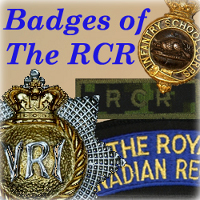
1. Introduction
2. Crowns, Cyphers and Controversy
3. Rare and Unusual Regimental Badges
4. Shoulder Flashes and Titles
1883
1894-1902, 1919-27
South African War
EviiR Badges (1902-11)
GvR Badges (1911-19)
St Edward's Crowns (1927-70s)
Maj Cock, M.C., Collection (1933)
Imperial Crowns (1926-50s)
Imperial Crowns (1960s-80s)
Dress Regs - 1960
Dress Regs - 1967
1980s
1990s
2000+
Woven Badges
Blazer Badges
Pipers' Badges
Belt Buckles
Miscellaneous
Crowns, Cyphers and Stars
RCR Headdress
Badged Brodies
Badge References
